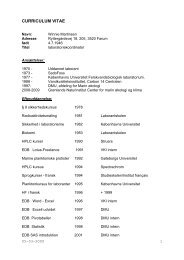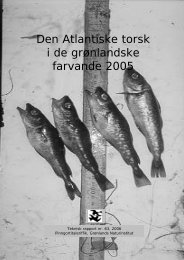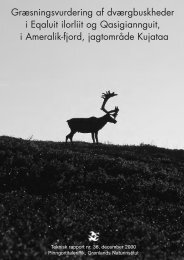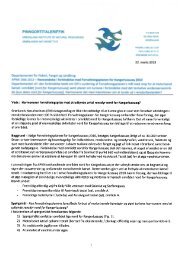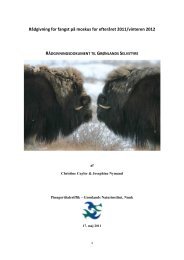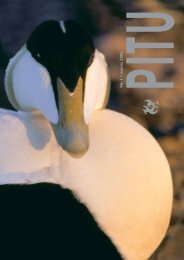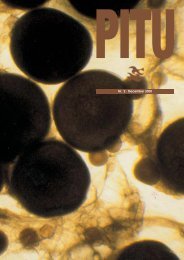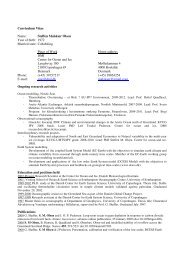Migration and breeding biology of Arctic terns in Greenland
Migration and breeding biology of Arctic terns in Greenland
Migration and breeding biology of Arctic terns in Greenland
You also want an ePaper? Increase the reach of your titles
YUMPU automatically turns print PDFs into web optimized ePapers that Google loves.
28<br />
migration <strong>in</strong>to tropical mar<strong>in</strong>e regions with low productivity <strong>and</strong> limited<br />
food availability. It is likely that this <strong>Arctic</strong> tern stop-over site may serve<br />
as a hot-spot area for other migrat<strong>in</strong>g seabirds, e.g. long-tailed skua (Stercorarius<br />
longicaudus) has been observed <strong>in</strong> high densities <strong>in</strong> this area dur<strong>in</strong>g<br />
ship-based surveys (D. Boertmann pers. com).<br />
The migration study also revealed a divide <strong>in</strong> the southbound migration<br />
<strong>of</strong> the <strong>Arctic</strong> tern. Just south (~10° N) <strong>of</strong> the Cape Verde Isl<strong>and</strong>, seven <strong>in</strong>dividuals<br />
migrated south along the coast <strong>of</strong> West Africa (as expected from<br />
r<strong>in</strong>g<strong>in</strong>g recoveries), while four <strong>in</strong>dividuals crossed the Atlantic Ocean<br />
to migrate south along the coast <strong>of</strong> South America. Furthermore, three<br />
<strong>in</strong>dividuals drifted east along the southern Polar Front <strong>and</strong> entered the<br />
Indian Ocean. Although divides <strong>in</strong> migratory routes are known <strong>in</strong> other<br />
avian species <strong>breed<strong>in</strong>g</strong> at a s<strong>in</strong>gle location, for example ospreys (P<strong>and</strong>ion<br />
haliaetus) <strong>breed<strong>in</strong>g</strong> <strong>in</strong> Sweden (Hake et al. 2001), the study on <strong>Arctic</strong> tern<br />
migration illustrates goal orientation at a global scale. Although the <strong>terns</strong><br />
travelled through vastly different areas, they all w<strong>in</strong>tered <strong>in</strong> a relatively<br />
restricted geographical area <strong>in</strong> the Weddell Sea.<br />
The <strong>Arctic</strong> tern migration study also highlighted differences <strong>in</strong> the pace<br />
<strong>of</strong> southbound versus northbound migrations. While the migration south<br />
to the w<strong>in</strong>ter quarters was conducted over a period <strong>of</strong> three months (average<br />
93 days <strong>and</strong> an average speed <strong>of</strong> 330 km per day), the northbound<br />
migration back to the <strong>breed<strong>in</strong>g</strong> sites was much faster. The <strong>terns</strong> covered<br />
the 25,700 km from the w<strong>in</strong>ter site north to 60º N <strong>in</strong> an average <strong>of</strong> 40 days.<br />
This long leg <strong>of</strong> migration was conducted with average daily distances <strong>of</strong><br />
520 km – with some <strong>in</strong>dividuals fl y<strong>in</strong>g up to 670 km per day. Unequal migration<br />
speeds <strong>of</strong> autumn versus spr<strong>in</strong>g are known from numerous bird<br />
species (Newton 2008) but, <strong>in</strong> this study, we were able to correlate the fast<br />
northbound migration with the prevail<strong>in</strong>g global w<strong>in</strong>d systems.<br />
Most studies on bird migration are performed on l<strong>and</strong> birds <strong>and</strong> much <strong>of</strong><br />
our underst<strong>and</strong><strong>in</strong>g <strong>of</strong> the mechanism beh<strong>in</strong>d migration is based on l<strong>and</strong><br />
bird studies. Seabirds are poorly represented <strong>in</strong> text books on migration<br />
(e.g. Newton 2008, Berthold 2001), even though it is amongst seabirds that<br />
the most spectacular migration pat<strong>terns</strong> are found. Even <strong>in</strong> modern seabird<br />
text books seabird migration may be described “as most seabirds migrate<br />
exclusively at sea, they have an opportunity to rest or feed whenever<br />
they feel like it: not an option for l<strong>and</strong> birds cross<strong>in</strong>g water or deserts”<br />
(Gaston 2004). Our study show that the <strong>Arctic</strong> tern migration <strong>in</strong> many<br />
ways resembles that <strong>of</strong> l<strong>and</strong> birds with dist<strong>in</strong>ct w<strong>in</strong>ter<strong>in</strong>g areas <strong>and</strong> stopover<br />
sites along the migration route, <strong>and</strong> a high level <strong>of</strong> synchrony <strong>in</strong> phenology<br />
amongst <strong>in</strong>dividuals.





